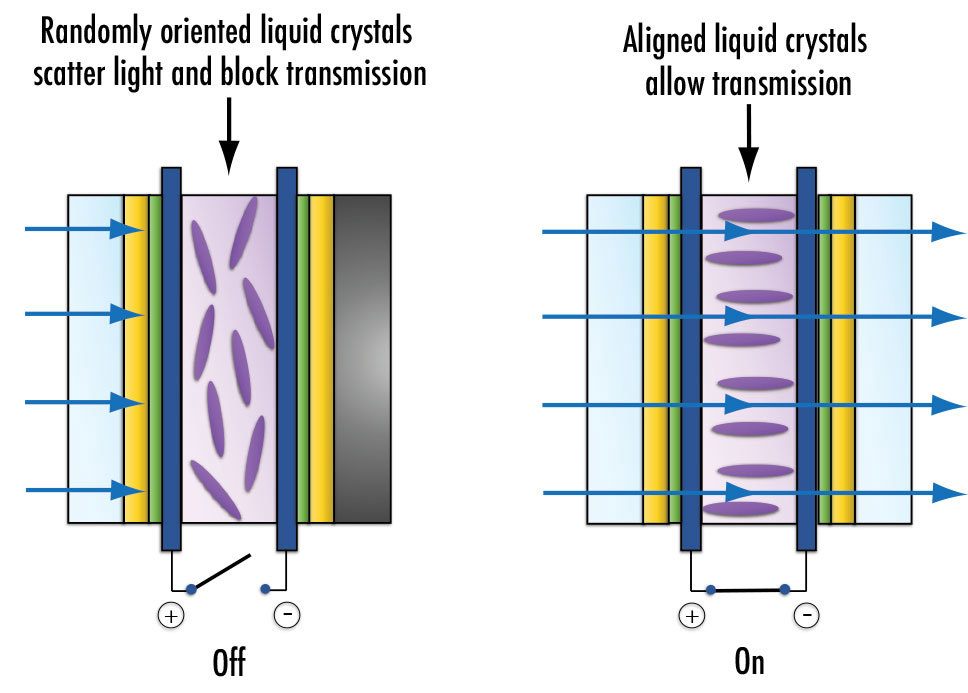

|
|
Standard electrochromic smart glass changes its transmission with applied voltage |
|
|
New transparent multifunctional smart glass also acts as both a display and an imaging system |
|
|
Multifunctional smart glass contains integrated microstructured optics invisible to the naked eye |
|
|
This revolutionary material has potential impacts in gesture recognition, smart homes, wearable technology, and much more |
Electrochromic glass, or smart glass, varies its transmission in response to an applied voltage and is gaining popularity in energy efficient homes, high end automotive windows, and other applications where precise control of transmitted light is beneficial. However, a new innovative type of multifunctional smart glass with invisible, integrated micro-optics also acts as both a display and an imaging system, opening up the possibilities for a myriad of new technologies.
Electrochromic glass is the technology commonly associated with “smart glass.” Many types of electrochromic glass contain a liquid crystal layer that allows the material to switch from a transparent state to an opaque state. When there is no voltage applied to electrochromic glass, the liquid crystals are randomly oriented, scattering incident light and preventing transmission. However, when a voltage is applied, the liquid crystals align, allowing light to transmit through the glass. The U.S. Department of Energy reports that about 30% of the electricity consumed in U.S. buildings is spent making up for energy lost through windows, so the widespread adoption of electrochromic glass for light control has the potential to significantly reduce energy consumption.1 Electrochromic glass is also used in other applications such as electronically dimmable windows for newer airplanes.

While electrochromic glass is useful for transmission control, new multifunctional smart glass developed by ZEISS introduces a wide range of other capabilities, such as eye tracking or gesture tracking, without any visible optical systems. Multifunctional glass contains a series of integrated microstructured optics that are completely invisible. Dr. Alexandre Gatto from ZEISS Microstructured Optics stated that, “you can use any size of glass you like with any number of functions. The smart glass will soon be able to illuminate, identify, filter and project. It’s a fantastic innovation that could be used to do great things in augmented reality and in the automotive industry.”

Multifunctional smart glass is still under development by ZEISS, but they showcased it in a gesture recognition demonstration at SPIE Photonics West 2019 in San Francisco, U.S. This technology has an immense range of potential applications from intuitive gesture recognition systems, smart homes with variable transmission glass surfaces that also act as displays, heads up displays for automotive windshields, and wearable technology for augmented reality. Similar technology is already used for semi-transparent displays in smart refrigerators and other types of advanced displays.
 Does Edmund Optics sell multifunctional smart glass or electrochromic glass?
Does Edmund Optics sell multifunctional smart glass or electrochromic glass?
 Does Edmund Optics sell any technology that utilizes liquid crystals like electrochromic glass?
Does Edmund Optics sell any technology that utilizes liquid crystals like electrochromic glass?
While they serve a different purpose than electrochromic glass, Edmund Optics sells Polarization Directed Flat Lenses containing a polymerized liquid crystal film. Depending on the polarization of incident light, Polarization Directed Flat Lenses will have either a positive or negative focal length. More information on this technology can be found here.
1.Bourzac, Katherine. “Smart Glass Made In One Step.” Chemical and Engineering News, 19 July 2012, cen.acs.org/articles/90/web/2012/07/Smart-Glass-Made-One-Step.html.
or view regional numbers
QUOTE TOOL
enter stock numbers to begin
Copyright 2024, Edmund Optics Singapore Pte. Ltd, 18 Woodlands Loop #04-00, Singapore 738100
California Consumer Privacy Acts (CCPA): Do Not Sell or Share My Personal Information
California Transparency in Supply Chains Act